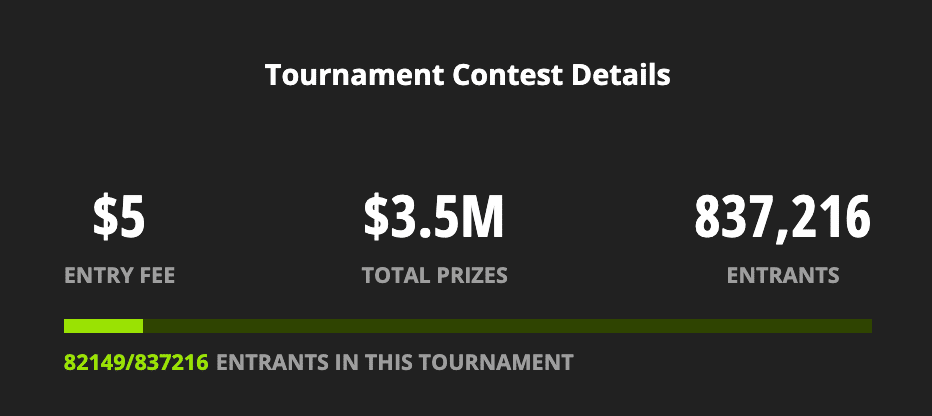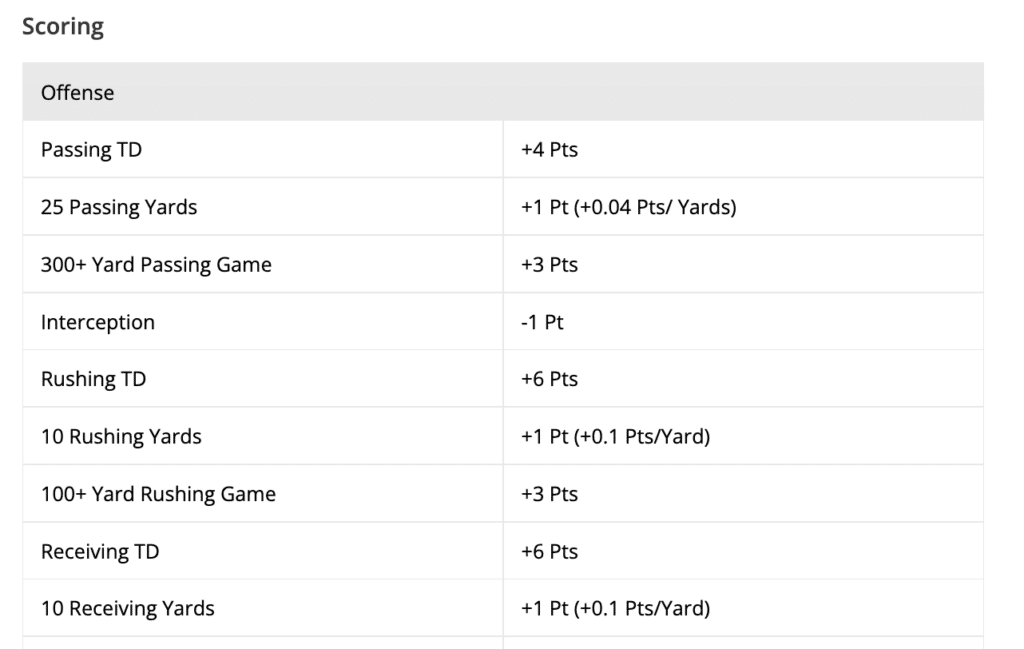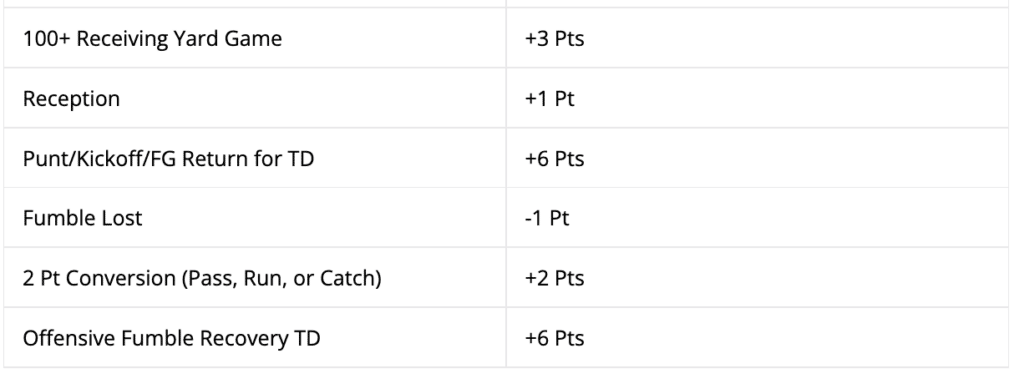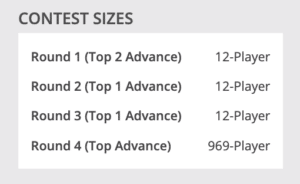In early May, DraftKings dropped 7 NFL Best Ball tournaments totaling about $5.5 Million. The headliner is the largest best ball tournament in history (based on number of entrants) – a $3.5 Million Prize Pool Millionaire Maker tournament with just a $5 entry fee.
That’s right, for just $5 you can draft a team on DraftKings with a shot to take down the $1 Million top prize. The one slight catch, however, is that you have to beat a little more than 837,000 of your closest friends on DraftKings.com.
The contest has a $1 Million top prize and is also approaching 1 million entrants. Crazy.
Below we’ll dive into our Playbook for this tournament. Every best ball tournament has it’s own nuances. Certainly a tournament with that many entrants is going to be different from other tournaments across the industry. But what does that mean?
That means that all the specific nuances about the particular tournament require a specific strategy dedicated strictly to that tournament. That strategy can (and probably should) differ for each individual, but either way it’s extremely important to take into account a variety of different aspects of the tournament:
- Contest Size
- Contest Timing
- Payout Structure
- Draft Environment
- Site Scoring
- Site Rosters
Tournament Overview
Before we dive into each of the variables, it’s important to illustrate just how different this tournament is compared to every other best ball tournament in the industry. This is the only contest of this size (800k+ entrants) with this low of an entry fee ($5).

It is the largest contest with the largest Week 17 final round, so that instantly creates a lot of unique variables for us to consider.
DK Scoring + Rosters


As you can see above, DraftKings has a few extremely different variables in their scoring.
First, it’s full point PPR. That is the same as Drafters, but different than Underdog‘s half point PPR scoring.
And maybe more importantly, they have 3 point yardage bonuses. So, if a Quarterback throws for 300 yards, he will receive an additional 3 points. If a player runs for 100 yards, they will also receive a 3 point bonus. And finally, if a player has 100 yards receiving they will gain 3 extra points.
While that may seem minor, when we get to the final in week 17, those bonuses can really pile up and give your lineup a bunch of extra points. On top of that, it creates even more advantages to correlating your lineups because it creates correlated scenarios for your players to receive these 3 points bonuses.
In extremely basic terms, if your QB has a good game, he’s likely going to throw for 300+ yards, so he will receive the 3 point bonus. In turn, that means his WRs are likely doing well, which gives them a better opportunity to receive a 3 point bonus for 100 yards themselves. And finally it also means the WR on the opposing team has a better opportunity for those 3 additional points because his team is in a game environment that is forcing more offensive production and aggressiveness.
Contest Size
It’s sort of hard to put into words how important the contest size is for this tournament. But the moral of the story is that however important you think it is, it’s still probably more important.
In this article on Week 17 Game Stacks, we discussed the specifics of just how much of the prize pool is allocated to Week 17. Long story short, you really don’t make any money unless you make the final round in Week 17. And even then, you might have a top 0.1% team in a contest with 900,000 entries and walk away with just $250.
That’s insane.
Knowing how big this field is going into your drafts is one of the most important variables that we can consider. And we’ll get to how we can build our strategy for that below.
Contest Timing
A variable about Best Ball tournaments that goes overlooked is the “timing” of drafts.
I don’t mean when you as an individual are drafting your teams (although we did cover that here), but how long this specific tournament is open with teams being drafted into it.
It’s probably not even necessary to say, but a tournament with nearly 1 million entries is going to take a while to fill. This contest is approaching 900,000 entrants, so naturally it’s going to be open for the entire draft cycle. Heck, it may not even fill all the way, and we might be able to enjoy some overlay.
But either way, it’s important to know going into your drafts that this contest isn’t one where you’re drafting just against others drafting in the same time pocket as you. In the above article about timing of drafts, you can see that there are both pros and cons to drafting early in the draft season and late.
Payout Structure
Within the payout structure, we are also going to include the “advance structure”.

For DraftKings, the advance structure is actually extremely straightforward.
You draft within your 12 team draft, and 2 of those teams in that 12 team league advance to the “playoffs” or Round 2.
In Round 2, you will compete against 11 other teams that have advanced out of their 12 team league. You must win that round against the other 11 teams in Week 15 (and Week 15 alone) to advance to Round 3.
In Round 3, you have the same situation as Round 2. Compete against 11 other teams that advanced from Round 2, and you must take 1st place in Week 16 (and Week 16 only) in order to advance to the Final Round (Round 4).
In Round 4, this is where it gets crazy. A whopping 969 teams will advance to Round 4. So if you are lucky enough to make it to this final round out of nearly 900k teams, you will still have to best almost 1,000 other incredibly strong teams in one singular week – Week 17 – in order to take home the 7 figure top prize.
Draft Environment
Whether or not you’re new to DraftKings Best Ball, or even best ball in general, you probably have still somehow heard about the draft lobbies on DraftKings. Ask any best ball player about drafts on DK, and they’ll all tell you how they are by far the softest (and whackiest) drafts in the industry right now.
On sites like Underdog or Drafters, it is incredibly rare to get people in your drafts building just truly “bad” teams. Whether that be reaching massively on countless players, drafting 8 tight ends, etc., those things just don’t really happen on other sites… but they do on DraftKings.
What that means is two-fold.
1 – We know inherently that we can build better teams on DK (higher projection, greater ceiling, ADP value).
2 – We know inherently that other competent drafters can build better teams on DK.
That’s great for our overall ROI, Advance Rate and Expected Value. But, it also means that we need to cognizant of the fact that if we can make that final round in Week 17, we are going to be staring down the barrel at some super squads.
Timing of Drafts
As mentioned above, I talked about when to draft best ball teams a little earlier this offseason.
Specifically for this $5 Milly Maker tournament on DraftKings, I think an even more extreme version of the “barbell strategy” is ideal. By barbell, I mean drafting almost entirely in two portions of the offseason.
1 – Early in the offseason before training camp (probably even before OTAs).
2 – Late in the offseason as close to the start of the season as possible.
In number 1 above, you are clearly taking on more uncertainty and risk, but that uncertainty and natural chaos of an NFL offseason gives you access to teams that will not be available later in the draft cycle. Players will get hurt this summer which will cause other players on their team to shoot way up in ADP. Or we will have uncertain situations (QB battles, backup RBs, general camp hype, etc.) play out in a way that drastically shifts ADP, meaning that you have access to potentially supercharged teams early in the offseason that you simply will not be able to get later.
In number 2, you are shutting yourself out of access to some potentially massive “values” that just only come from early drafts, but you gain a couple different things. First, you get a lot more information at your disposal when drafting. You’ve learned about any injuries, you have gotten the training camp reports and even some preseason action to understand the depth charts. Second, you are theoretically drafting against a slightly more casual best ball drafter at that time given that we would think it would be mostly more dedicated individuals drafting earlier in the summer.
There is no real wrong way to go about how you time your drafts, but as I said, I think the extreme barbell approach is much more applicable to this particular tournament than any other Best Ball tournament in existence.
We have a truly massive contest with a huge final round and plenty of high powered teams. We are going to want access to some of these early teams from early summer drafts in order to give us the upside that comes with them. Will it work out in our favor? There’s no way to say, but it’s the sort of high risk, high upside move that we want in a tournament with this specific payout structure, size, etc.
On the other end, we then likely want to ignore some of the middle part of the summer where you still don’t have much of an information edge and you don’t get any more casual competition. We can focus the rest of our drafts very, very late where the DraftKings draft lobbies get TONS of casuals pouring in. Last year specifically the drafts in the 1-2 weeks leading up to the season were the softest drafts that existed all year.
Roster Construction
I know that everyone hates this portion of just about every bit of analysis. Zero RB? Robust RB? Hero RB? Some other new structural name we haven’t heard yet?
However, I do think this is really important for this particular tournament. I know I keep reiterating it, but it’s that important. This is a truly massive tournament. Almost 900,000 entries with almost 1,000 teams in the final round.
The other big element to consider is the scoring on DraftKings. Full point PPR is a big difference from a site like Underdog, but another huge difference is the 3 point bonuses for 300 yards passing and 100 yards rushing/receiving.
When you combine full PPR with those bonuses, it heavily favors the passing attack. There just so happens to be a roster construction (or two) we can use that heavily favors the passing attack, takes advantage of the chaos of both the offseason and regular season, and allows our teams to get stronger over the course of the season (leading into that ever important week 17).
Yes, it’s Zero RB (and Hero RB).
it’s not to say you should have 100% Zero RB teams or never draft any SuperHero or Robust RB teams, but given the structure of this particular tournament, the scoring on the site and all these other variables, we can give ourselves the best chance to win by leaning much more heavily into the elite passing game options early in drafts. That doesn’t necessarily mean avoiding all early RBs, but simply focusing more heavily on non-RBs in the early rounds.
We also get the benefit of knowing that Zero RB is the least utilized roster construction in all of Best Ball, which gives us many more paths to a unique team and thus cleaner path in the Week 17 1,000 team Final.
Correlation – Week 17 Stacking
Think about what we said above for just one second. You can have a top 0.1% team in a Best Ball tournament of approaching 1 Million teams, and if it doesn’t perform well in Week 17 you walk away with just $250.
Look, who doesn’t want $250. I’ll take it if you’re offering, but if I draft one of the best teams in all of Best Ball, I’d personally prefer to be rewarded with a little more upside than a nice steakhouse dinner, particularly when we know someone is going home with $1 Million.
We know that the contest is huge, with a weak draft environment and top heavy payouts that are nearly all in Week 17. So what do we do?
We focus on Week 17.
Week 17 is where essentially ALL the money is won. All of your Expected Value is coming from this week.
Learn how to use the NFL Schedule and particularly the Week 17 schedule to your advantage.
It sounds crazy to focus so heavily on just one week out of the NFL season, especially one that is so far away. But don’t think about it like we are trying to predict Week 17 games right now. We shouldn’t expect to be accurate in any sort of projection for that week. But we aren’t even really projecting the week. We are simply correlating pieces that we draft within their matchups for that week. You’re not forcing in stacks of what you think the best Week 17 game is right now, but you’re using it as a tiebreaker between different players in the same tier of a draft. No one expected the Lions and Seahawks game to be the best game in Week 17 last year, but correlating that game with Rashaad Penny and Amon-Ra St. Brown was the lynchpin to winning Best Ball tournaments in 2021 (on top of Ja’Marr Chase).
Combine all that with what you read above about the full PPR scoring with 3 point bonuses, and that’s even more reason to correlate. If we “Draft Like We’re Right“, when one scenario comes true, another player or multiple players stand to benefit. So from just that one scenario playing out, we give ourselves access to a significant amount more points when you factor in full PPR for our pass catchers and those bonuses. Simply by correlating the right game or two, you can rack up 300 & 100 yard bonuses across your entire lineup with the extra points for each catch in the games that break your way from a game environment perspective.
If you’re looking to discuss this Playbook a little more with both myself and an incredible community of drafters, make sure you hop in our FREE Best Ball Discord.




